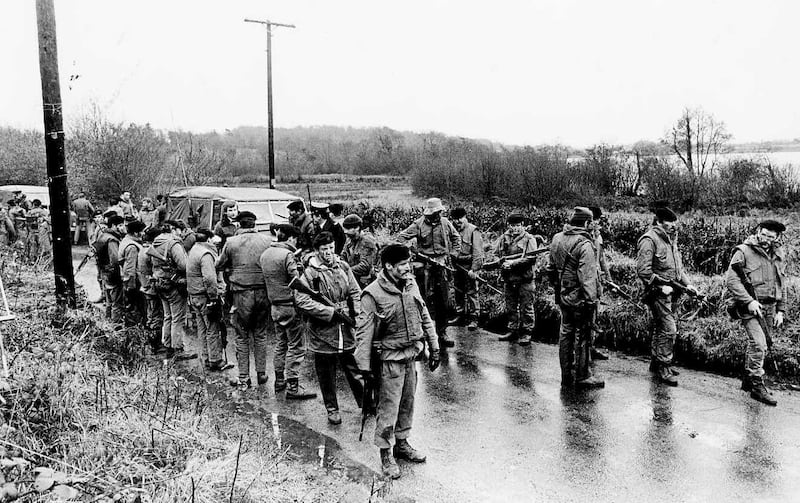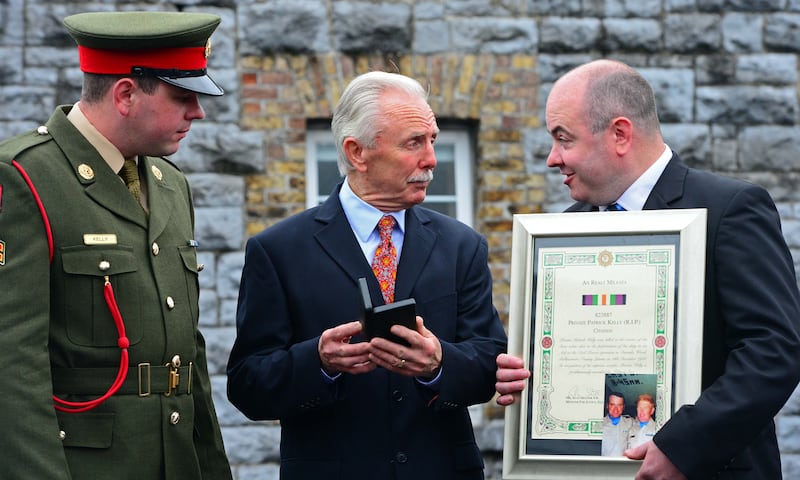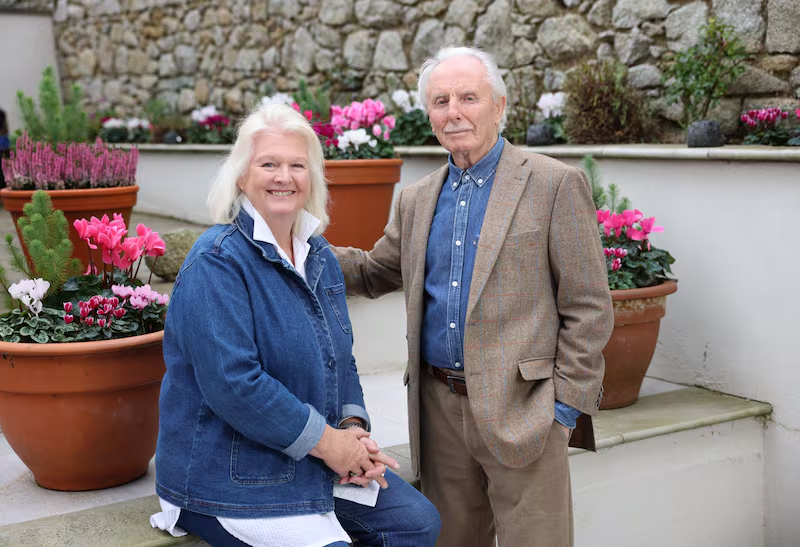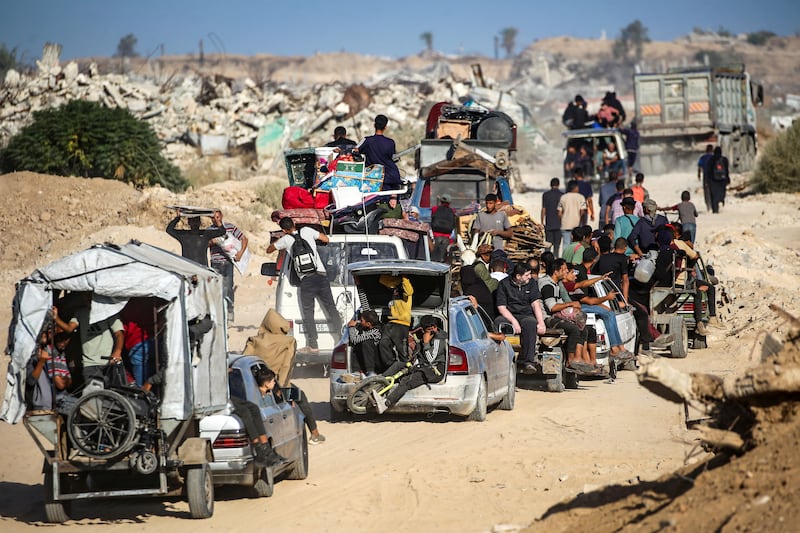On December 16th, 1983, the Provisional IRA shot dead Private Patrick Kelly and recruit Garda Gary Sheehan at Derrada Wood outside Ballinamore in Co Leitrim.
Both men were riddled with bullets by a gang which had been holding Quinnsworth managing director and chairman Don Tidey hostage for 23 days. They then proceeded to take hostage seven Irish security force personnel, gardaí and soldiers, and march them as human shields across a field at gunpoint.
They went one way and Tidey went another. “Le moment critique”, as he called it, that he had learned about in his military training, had arrived.
He hit the ground and did a roll down a sharp incline into bracken. He was now free of his captors, but when he lifted his head he found himself with the nozzle of a rifle pointed at his temple.
READ MORE
Tidey would find out months later from the then chief-of-staff of the Defence Forces that the soldier holding that rifle, Pte Patrick McLaughlin, had his finger on the trigger. To him this frightened-looking creature dressed in combat fatigues with a thick beard looked like an enemy and the movements Tidey made looked like he was reaching for a gun.

“By the grace of God, he didn’t pull the trigger,” Tidey recalls now. Another gun was put to his head moments later by Det Insp Bill Somers as he attempted to ascertain whether the man in front of him was friend or foe. Even then the danger had not passed.
The IRA gang commandeered a car and began firing from it as they sped past. Tidey was beside Det Sgt Donal “Donie” Kelleher when the latter was shot in both legs and seriously wounded.
Tidey again hit the ground. “I felt a very intense sharp pain in my arm and thought that I had been hit. To my great relief, the sharp pain and numbness in my arm was improving. I had only hit that sensitive nerve that is in the elbow.”
Now aged 88, the years have not diminished Tidey’s natural authority, nor his memory. He retired as a supermarket executive at the age of 62, having built his employer Associated British Food’s interests in Ireland into a £630 million business which was sold to Tesco in 1997.
He had been a low-profile supermarket executive living in Ireland for 18 years when he was kidnapped.
Yet, for the 23 days that he was held captive between November 24th and December 16th of 1983, his plight transfixed the nation.
A vigil was held at his Anglican parish church, Whitechurch, at the foot of the Dublin Mountains, every evening; his employers broadcast appeals on televisions installed in every Quinnsworth store; thousands of gardaí and Army personnel were involved in what was then the biggest manhunt in the history of the State.

It wasn’t just the life of a man that was at stake but the security of the State itself against republican paramilitaries. It was a year in which the Provisional IRA kidnapped the racehorse Shergar and attempted to kidnap Tidey’s boss, the wealthy Canadian businessman Galen Weston. The latter led to a shoot-out with armed gardaí at Roundwood in Co Wicklow that left four senior IRA would-be kidnappers injured.
The Provisional IRA shot and fatally wounded Portlaoise prison warden Brian Stack in March and tried to flood the Republic with counterfeit money in an attempt to raise funds a month later. They demanded IR£5 million for Tidey’s release; the Irish and British governments forbade it to be paid in any circumstances.
At the same time as gardaí were searching for Tidey, they were also looking for the notorious Irish National Liberation Army (INLA) terrorist Dominic “Mad Dog” McGlinchey, who had jumped bail in December 1982. McGlinchey and his wife Mary held gardaí at gunpoint on two occasions and tied them up while the search for Tidey was ongoing.
A sense of anarchy prevailed in the State. “There is not one word of good news [about Tidey] and we are all sick with worry,” then minister for education Gemma Hussey wrote in her diary a week after Tidey was kidnapped.

While the country prayed and fretted about his fate, Tidey spent his nights in a depression in the ground overlaid by sheets of black plastic and with a crude canopy of the same material overhead for ineffectual protection from the elements.
During the day he was chained to a tree while at night in the hideout he was handcuffed, blindfolded and his ears tightly bandaged, to stop him from hearing.
He never got to see the dimensions of his makeshift prison. “When it rained, the outer cover filled. I could feel the polythene with the rain almost resting on my nose.”
Nor did he get a chance to identify his captors. In 2008, the trial of Brendan “Bik” McFarlane for the false imprisonment of Tidey collapsed at the Special Criminal Court. Tidey was present, but the man in the dock was a stranger. “Whether he was [in Derrada Wood] or wasn’t, I couldn’t know.”
His military training far exceeded that of his abductors. The IRA had kidnapped a man whose life had been shaped by the second World War and whose interest in all things military had developed from the earliest age. Born in Hackney, east London, in September 1935, he was evacuated as a child to live with relatives in Burgess Hill in east Sussex.
His new home was only 15km from the English Channel. He remembers German planes coming in overhead to bomb London every night, flying so low on occasions he could see the crews as they strafed the area.
[ Gardaí confirm Provisional IRA killed garda and soldier during Don Tidey kidnapOpens in new window ]
He also witnessed the build-up to the D-Day landings. He had a wooden “rifle”, and would stand to attention and make the army salute as convoys of tanks, artillery and troops made passed his front door on their way to the coast. He joined the Combined Cadet Force at school in Brighton and represented it at the coronation of Queen Elizabeth in June 1953. After two years of national service, he joined Britain’s territorial army for further mandatory service, finishing at the rank of captain after nine years.
Tidey insists it was his military training that helped him to endure the deprivations of his captivity.
With manacles on his wrists and ankles, his movements were severely limited, so he did a form of isometric exercise he had learned in the British army that involves the static contraction of muscles. “The body is a remarkable machine. [This exercise] meant that it was strengthened and maintained as if I was actually moving.”
His discipline meant he would never attempt to ingratiate himself with his captors. “It was a deliberate policy for me not to engage. I just wanted to keep my counsel and they clearly were going to keep theirs. There was no small talk.”
He inherited a strong religious faith from his parents, who were full-time officers in the Salvation Army.

After a peripatetic existence as a supermarket executive in Ireland, which included living in the North during the Troubles, he and his family finally settled in Woodtown near Rathfarnham, at the foot of the Dublin Mountains, in 1979.
They hoped it would bring them tranquillity, but a year later his wife Janice died from leukaemia at the age of 38, leaving Tidey as a widower with three children. The youngest, Susan, was just 10.

During his captivity he would reflect on a prayer, originally attributed to the 16th century Spanish nun St Teresa of Ávila, which he knew by heart and which concludes: “Who God possesseth/In nothing is wanting.”
Still, he ponders, why bad things happen to good people. “Garda Sheehan and Private Kelly were killed in front of me. And I was so close to it, I heard the pin taken out of [a] grenade. And I emerged unscathed, too, from the indiscriminate gunfire that wounded Donal Kelleher beside me. The fact of the matter is that I survived in some miraculous way.”

In the years since Derrada Wood, he has been assiduous in turning up for events commemorating the two men who died rescuing him.
Earlier this year too, he turned up for the ceremony where Kelleher was posthumously awarded a bronze Scott Medal for his actions at Derrada Wood. The pair had called each other on December 16th every year. The last time they spoke they talked about meeting up in the new year. Kelleher, however, died from cancer last February at the age of 68.

On the day after Tidey’s release, his sons and daughter were beside him when he gave a press conference. Over the coming decades, he turned down multiple media requests for interviews.
He had also politely turned down requests from my co-author Tommy Conlon and I, but eventually changed his mind when we told him we were proceeding with the book anyway. If we were going to write about him, he wanted it to be accurate. “Retail is detail,” he would frequently say while arguing the minutiae of some aspect of his life or another.
Above all, he co-operated because he believes that fate and “extraordinary coincidences” have played such an important part of his life. He had been a manager in Marks & Spencer in Hammersmith when a man from head office casually inquired whether he knew anybody who would be interested in working for Ben Dunne in Ireland.
The biggest coincidence of all was meeting the woman who would become his second wife following his kidnapping. “The coincidences were linked so that it was meant to be to bring me to the place where I am now,” he says.
His daughter Susan Tidey was in the car on the morning her father was dragged from it by his abductors. Tidey had been bringing her to school at Alexandra College in Dublin, as per normal. Susan was also dragged from the car and thrown on the ground.
The teachers at Alexandra were particularly attentive to her during the ordeal. One of them, Barbara Dunne, who was a housemistress, brought the boarders to Whitechurch for the vigils.
Ms Dunne, as she was then, was also head of the art department, and nurtured Susan’s talent in the subject after the kidnapping. She and Tidey met to discuss Susan’s progress, and they developed a relationship outside the school. Without his kidnapping, he insists they would not have met. They married in 1986.
“Barbara has been so strongly and lovingly supportive in all this time, a rock amidst the shifting sands of life,” he says.

The pair have many shared passions, especially for sport. They are immensely proud of their daughter Saskia Tidey (30), who qualified in sailing for her third successive Olympic games recently. She represented Ireland in 2016 but got approval from the Irish Olympic Committee (IOC) to compete for Team GB at the Tokyo 2020 Olympics (held in 2021), having failed to find a suitable sailing partner in Ireland for her 49er FX skiff event.

There have also been the “greater sadnesses” – his eldest son Andrew died from cancer aged 53 in 2015, leaving behind a wife and three children.
“I have had a lot of highs and lows. By the grace of God, I am where I am.”
The Kidnapping, A Hostage, a Desperate Manhunt and a Bloody Rescue that Shocked Ireland, by Tommy Conlon and Ronan McGreevy, is published by Penguin Sandycove on October 26th, priced €17.99





















